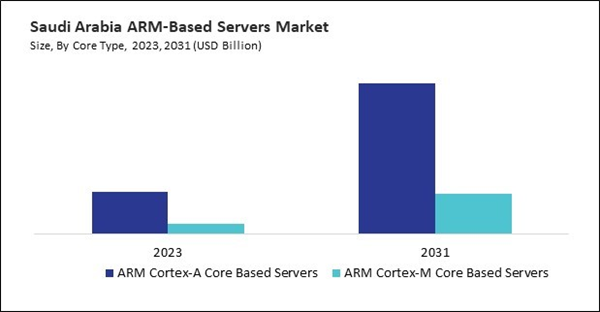The Latin America, Middle East and Africa ARM-Based Servers Market is expected to witness market growth of 16.8% CAGR during the forecast period (2024-2031).
The Brazil market dominated the LAMEA ARM-Based Servers Market by Country in 2023, and is expected to continue to be a dominant market till 2031; thereby, achieving a market value of USD328.7 million by 2031. The Argentina market is showcasing a CAGR of 17.5% during 2024-2031. Additionally, the UAE market would register a CAGR of 15.7% during 2024-2031.
The rising demand for cloud computing services has been a significant catalyst for the market. The proliferation of cloud-native applications that do not require the extreme computational power of x86 servers has further opened the door for these servers to play a prominent role in cloud infrastructure. The proliferation of 5G networks and the rapid growth of IoT (Internet of Things) devices have a transformative impact on the demand for these servers.
By 2025, 5G networks will be anticipated to encompass one-third of the population, as per the GSMA. Businesses in a variety of sectors are utilizing 5G technology to facilitate the vast quantities of data produced by connected IoT devices, as it offers significantly quicker, more reliable, and low-latency connectivity. These servers provide the necessary computational power without consuming large amounts of energy. They are ideal for applications where performance and energy efficiency are critical, such as in smart cities, industrial IoT, and autonomous systems.
In Brazil, the growth of cloud computing is driving the need for ARM-based servers. Brazil has seen an expansion of its cloud sector. Government-backed initiatives, like the Cloud First Policy, prioritize cloud adoption in public services, fueling demand for scalable and energy-efficient infrastructure. ARM-based servers are becoming preferred for managing data centers and cloud platforms due to their lower power consumption and efficiency, aligning with Brazil’s broader sustainability goals. Therefore, the region is expected to see continued growth in ARM-based server demand, driven by investments in telecom, cloud computing, and smart infrastructure projects.
The Brazil market dominated the LAMEA ARM-Based Servers Market by Country in 2023, and is expected to continue to be a dominant market till 2031; thereby, achieving a market value of USD328.7 million by 2031. The Argentina market is showcasing a CAGR of 17.5% during 2024-2031. Additionally, the UAE market would register a CAGR of 15.7% during 2024-2031.
The rising demand for cloud computing services has been a significant catalyst for the market. The proliferation of cloud-native applications that do not require the extreme computational power of x86 servers has further opened the door for these servers to play a prominent role in cloud infrastructure. The proliferation of 5G networks and the rapid growth of IoT (Internet of Things) devices have a transformative impact on the demand for these servers.
By 2025, 5G networks will be anticipated to encompass one-third of the population, as per the GSMA. Businesses in a variety of sectors are utilizing 5G technology to facilitate the vast quantities of data produced by connected IoT devices, as it offers significantly quicker, more reliable, and low-latency connectivity. These servers provide the necessary computational power without consuming large amounts of energy. They are ideal for applications where performance and energy efficiency are critical, such as in smart cities, industrial IoT, and autonomous systems.
In Brazil, the growth of cloud computing is driving the need for ARM-based servers. Brazil has seen an expansion of its cloud sector. Government-backed initiatives, like the Cloud First Policy, prioritize cloud adoption in public services, fueling demand for scalable and energy-efficient infrastructure. ARM-based servers are becoming preferred for managing data centers and cloud platforms due to their lower power consumption and efficiency, aligning with Brazil’s broader sustainability goals. Therefore, the region is expected to see continued growth in ARM-based server demand, driven by investments in telecom, cloud computing, and smart infrastructure projects.
List of Key Companies Profiled
- ZTE Corporation
- Lenovo Group Limited
- Oracle Corporation
- Hewlett Packard Enterprise Company
- Huawei Technologies Co., Ltd. (Huawei Investment & Holding Co., Ltd.)
- Marvell Technology Group Ltd.
- Cloudflare, Inc.
- Amazon Web Services, Inc. (Amazon.com, Inc.)
- Microsoft Corporation
- Ampere Computing LLC
- Arm Limited (SoftBank Group Corp.)
- NVIDIA Corporation
Market Report Segmentation
By Core Type
- ARM Cortex-A Core Based Servers
- ARM Cortex-M Core Based Servers
By Processor
- 64-bit
- 32-bit
By OS
- Android
- iOS
- Windows
By Vertical
- Telecommunications
- Automotive
- Healthcare
- Oil & Gas Extraction
- Bioscience
- Industrial Automation
- Other Verticals
By Application
- Mobile Computing
- 3D Graphics
- Internet of Things (IoT)
- Smart Homes
- Wearables
- Sensors
- Enterprise & Infrastructure Networking
- Wireless Communications
By Country
- Brazil
- Argentina
- UAE
- Saudi Arabia
- South Africa
- Nigeria
- Rest of LAMEA
Table of Contents
Chapter 1. Market Scope & Methodology
Chapter 2. Market at a Glance
Chapter 3. Market Overview
Chapter 4. Competition Analysis - Global
Chapter 5. LAMEA ARM-Based Servers Market by Core Type
Chapter 6. LAMEA ARM-Based Servers Market by Processor
Chapter 7. LAMEA ARM-Based Servers Market by OS
Chapter 8. LAMEA ARM-Based Servers Market by Vertical
Chapter 9. LAMEA ARM-Based Servers Market by Application
Chapter 10. LAMEA ARM-Based Servers Market by Country
Chapter 11. Company Profiles
Companies Mentioned
Some of the key companies in the LAMEA ARM-Based Servers Market include:- ZTE Corporation
- Lenovo Group Limited
- Oracle Corporation
- Hewlett Packard Enterprise Company
- Huawei Technologies Co., Ltd. (Huawei Investment & Holding Co., Ltd.)
- Marvell Technology Group Ltd.
- Cloudflare, Inc.
- Amazon Web Services, Inc. (Amazon.com, Inc.)
- Microsoft Corporation
- Ampere Computing LLC
- Arm Limited (SoftBank Group Corp.)
- NVIDIA Corporation
Methodology

LOADING...









